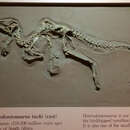en
names in breadcrumbs


Heterodontosaurus tucki is a species of heterodontosaur, a primitive group of dinosaurs that possess bird-like hips (also called ornithischian hips).They are known from the early Jurassic period, (200 to 176 mya).Fossils have been found primarily in South Africa and dated to between 196.5 and 189.6 million years old.The first heterodontosaur (Geranosaurus atavus) was described from fragmentary fossils in 1911 (Broom 1911).A more complete fossil skull of H. tucki was found in the Clarens Formation and described much later in 1962 (Crompton & Charig 1962).Heterodontasaur specimens have also been found in South America (Novas 2009, Baez & Marsicano 2014), Mexico, the US, and England, but these are fragmentary and largely undescribed (Butler et al 2008, and references therein).
Heterodontosaurus tucki was a small theropod (bipedal dinosaur with small forelimbs) with long hind limbs that made it a fast runner.It grew to about 1 m (3 ft) in length, and largest known skull is 108 mm long (Norman et al 2011). The forelimbs of H. tucki had five fingers, and even appears to have had an opposable digit, which gave it far more dexterity than most other theropods (Fastovsky & Weishampel 2012). H. tucki is most notable for its unusual teeth, the source of the name “Heterodontosaurus,” meaning, “different-toothed lizard.” Unlike most dinosaurs, this creature had three distinctly different types of teeth: incisor-like front teeth, well-developed caniniform tusks with a serrated cutting edge, and a set of tall, flat-crowned cheek teeth for grinding food, with their crowns closely packed so as to be almost contiguous (Novas 2009). Subtle differences in tooth types have been documented in several dinosaur groups, but such marked heterodonty is unusual (Norman et al 2011).
Due to the rarity of fossils, there is very little consensus on the taxonomy and systematics, as well as the ecology, of this creature. It is known, however, that its diet was herbivorous, implying that the large canines served some other purpose, such as for mating display or opening termite mounds. It has been suggested that the presence of canines allowed for occasional consumption of animal food, and even that this group represents a transition to herbivorous dinosaurs (Butler et al 2008).
Very little is known about the ecology of Heterodontosaurus tucki, because fossils are very rare.It is known that this dinosaur was an herbivore, like other ornithischians. Its relatively dexterous forelimbs would have allowed the animal to grasp food and manipulate it (Dodson et al 1993). It has been suggested in the past that the large canine-like teeth of H. tucki are a sexually dimorphic feature, but the presence of fully developed canines in a juvenile skull suggests that their function was instead defensive or adaptive for occasional omnivory (consumption of both plant and animal food) (Butler et al 2008).
Though fossils are rare, they have been found in a variety of places, suggesting that this peculiar group managed to disperse widely and become fairly successful during its existence (Norman et al 2001).
Heterodontosaurus tucki was a small theropod (bipedal dinosaur with small forelimbs) with long hind limbs that made it a fast runner.It grew to about 1 m (3 ft) in length, and largest known skull is 108 mm long (Norman et al 2011). According to the paleobiology database, its estimated mass is 4.24 kg. The forelimbs of H. tucki had five fingers, and even appears to have had an opposable digit, which gave it far more dexterity than most other theropods (Fastovsky & Weishampel 2012). H. tucki is most notable for its unusual teeth, the source of the name Heterodontosaurus, which means ‘different-toothed lizard.’ Unlike most dinosaurs, this creature had three distinctly different types of teeth: incisor-like front teeth for snipping vegetation, well-developed caniniform tusks with a serrated cutting edge, and a set of ten tall, flat-crowned cheek teeth for grinding food, with their crowns closely packed so as to be almost contiguous (Novas 2009). Subtle differences in tooth types have been documented in several dinosaur groups, but such marked heterodonty is unusual (Norman et al 2011).
Interestingly, fossils of Heterodontosaurus all lack evidence of the constant tooth replacement exhibited by most reptiles. Even a juvenile skull described by Butler et al (2008) lacked replacement teeth. It has been suggested in the past that the large canine-like teeth of H. tucki are a sexually dimorphic feature, but presence of fully developed canines in the juvenile skull suggests that their function was defensive or adaptive for occasional omnivory (consumption of both plant and animal food) (Butler et al 2008).
Little is known about the systematics of Heterodontosaurus tucki, as well as its genus. There is no question that this group is ornithischian (bird-hipped dinosaurs).Birds did not evolve from this group but rather from the ‘lizard-hipped’ (saurischian) dinosaurs. The most prevailing theory holds that heterodontosaurs are a basal ornithischian group, and sister group of Genasauria (Butler et al 2011, Norman et al 2011).